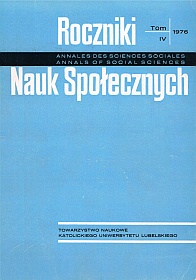Środowisko rodzinne nieletnich przestępców
Abstrakt
The author attempts to prove that juvenile delinquency belongs to the category of social maladjustment of children and adolescents directly and unmistakably resulting from unsuccessful socialization within the family. He agrees that the family continues to play the essential part in educational processes. The author confines himself to the discussion of environmental factors in the process of juvenile delinquency considering the milieu of primary importance in shaping the personality type. These are atmosphere of the family life, demographic structure of the family, desintegration, living conditions, lack of effective control over the children’s behaviour mother’s employment, etc.
Among the factors directly influencing atmosphere of the family life and hence the socialization of young people, alcoholism in the family seems to be of crucial importance. Young people of such families constitute according to A. Pawelczyńska 53 per cent of the entire population. The fact can be explained by frequent rows involving bodily harm and mutual accusations which force the child to escape from the drunken parent. Not only does it hinder proper socialization, in the family but also makes easier the influence of criminal groups. Young people seek satisfaction of their needs outside their own home. Children of poorer families often commit theft while those who are better off turn to acts of vandalism. Apart from alcoholism also breaking up of the family destitute of a parent brings about juvenile delinquency. Children of broken up families constitute over 30 per cent of law offenders. Subsequend re-marriage of the parents exercises equally unfavourable influence. Mother’s employment is also a negative factor. Quoting A. Podgbrecki, the author stresses that religious practice influences the attitudes of young people, i.e. „juvenile delinquency is less prevalent among church-goers”.
Copyright (c) 1976 Roczniki Nauk Społecznych

Utwór dostępny jest na licencji Creative Commons Uznanie autorstwa – Użycie niekomercyjne – Bez utworów zależnych 4.0 Międzynarodowe.


